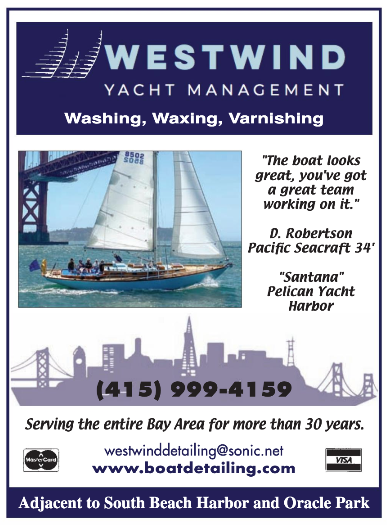
StFYC Woodies Invitational on the Cityfront
This past weekend the St. Francis Yacht Club hosted three fleets for the classic Woodies Invitational. Two fleets were woodies and fiberglass — Knarrs and Folkboats — and the other, the Carl Schumacher-designed Alerion 28, participated in the “spirit of tradition.” The annual event follows the Master Mariners race and the Wooden Boat Show as another showcase for the classic beauties of sailing, plus an opportunity to keep the competitive juices alive. Photographer Chris Ray was out capturing the action.
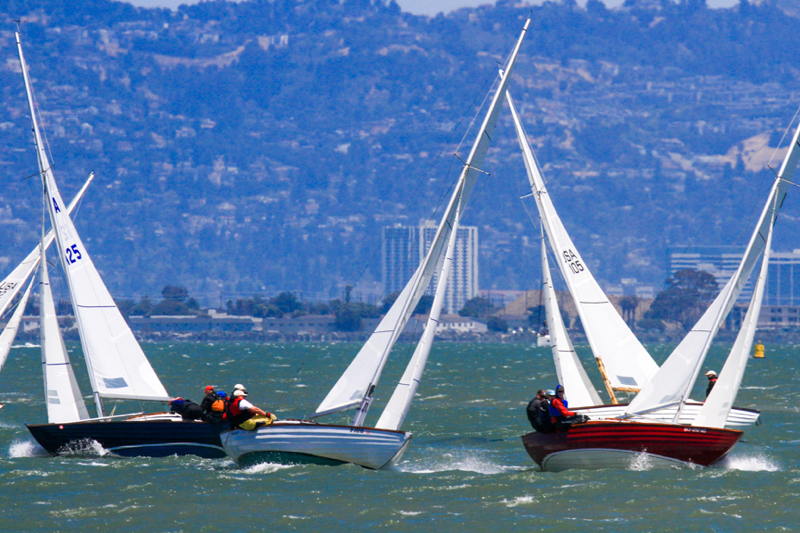
The still-popular Folkboat fleet first showed up in the pages of Latitude 38 in our May 1977 issue, when the international fleet of 30 Folkboats competed for their world championship in the San Francisco Cup for Nordic Folkboats.
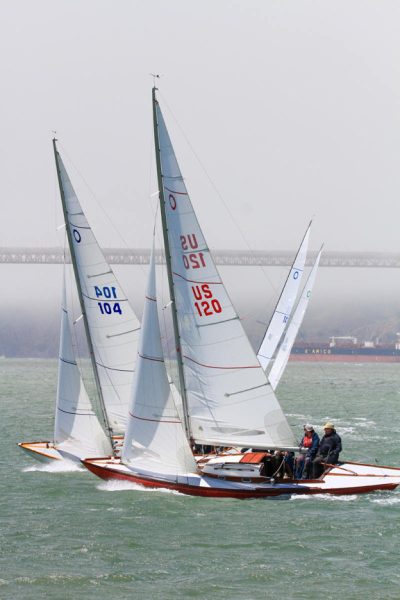
The event featured six races across three days. The boats sailed in fresh, cool summer breezes sprinkled with sunshine, and a flood current to help keep the Bay flat and decks a little drier than normal on these low-freeboard boats.

The Knarr fleet remains one of the most active on San Francisco Bay. Like the Folkboat, it is a Scandinavian design first launched in the mid-1940s. It first appeared in Latitude 38 in October 1977.
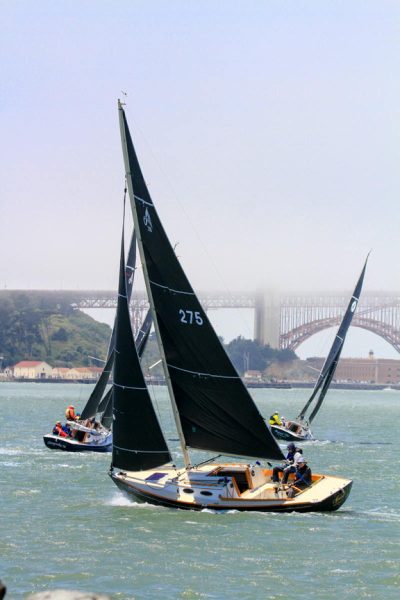
The San Francisco Alerion fleet is one of the largest in the nation. There are about 35 of the comfortable 28s on the Bay, with eight showing up to compete. Many are sailed for pleasure with guests in the large cockpit, while others like them for shorthanded racing. They first came off Carl Schumacher’s drawing board in his Alameda office in about 1990.
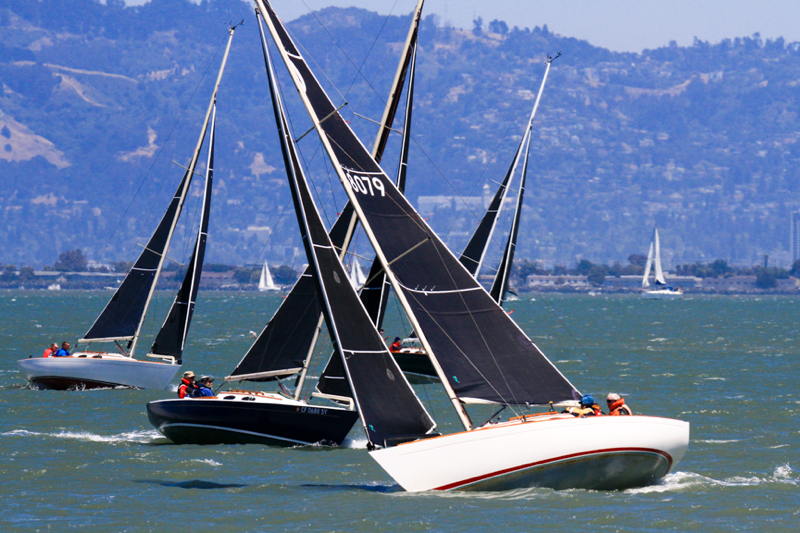
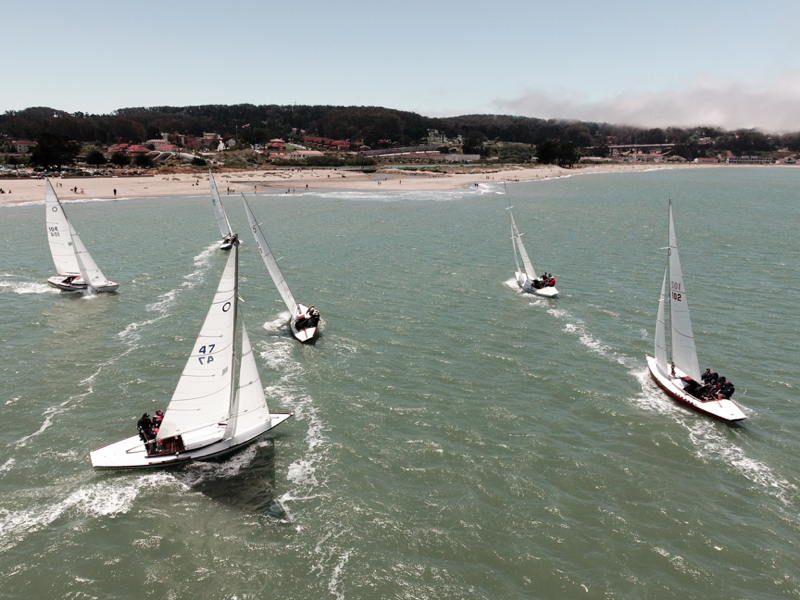
After three days of racing, the winner of the Folkboat fleet was Sausalito Yacht Club’s David Wilson with his crew aboard Windansea. In the Knarr fleet, St.FYC’s Jon Perkins and Kurt Hemmingsen took the top position aboard Kulani. In the Alerions it was St. Francis Yacht Club again, with Jim Titus and Bill Claussen winning aboard Allegro non Troppo. Complete results are here.
53rd Transpac Starts Tomorrow
The 53rd Transpac race from Los Angeles to Hawaii starts tomorrow, with divisions 7, 8, and 9, plus the multihulls, heading west for the 2,225-mile sail to the fabled Hawaiian Islands in the Pacific.
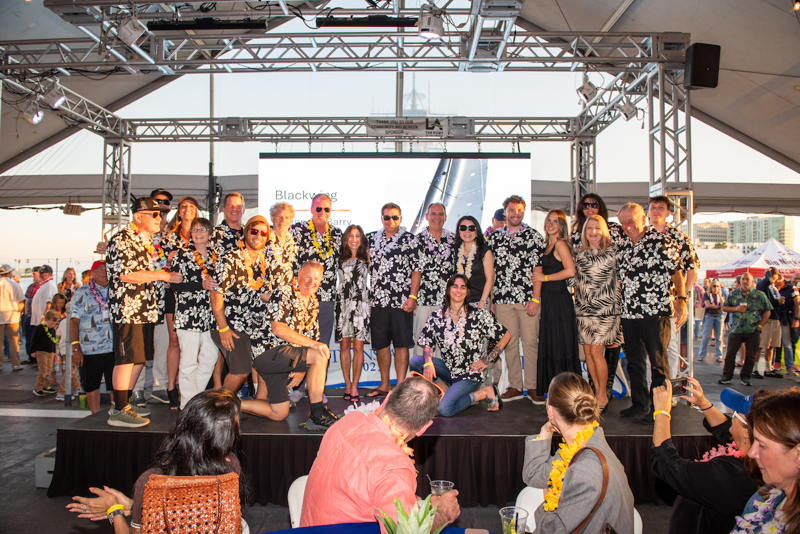
The 53rd edition of the biennial Transpacific Yacht Race, established in 1906 and organized by the Transpacific Yacht Club, celebrated the official start of 2025 festivities at Saturday night’s Aloha Send Off Party, hosted by race partners Fess Parker Winery and Third Window Brewing, aboard the retired battleship USS Iowa, docked in San Pedro.
The 53-strong Transpacific Yacht Race fleet officially begins this epic bluewater contest in a series of three pursuit-style starts on July 1, 3 and 5, racing from the starting line off California’s Point Fermin to the finish line off Oahu’s world-famous Diamond Head. For many sailors, Saturday night’s Aloha Send Off Party signaled the successful conclusion of the crucial race-before-the-race.
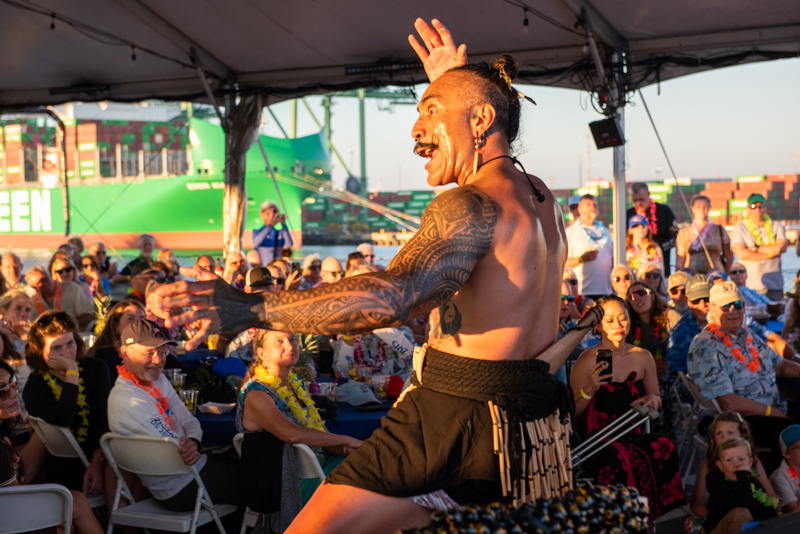
“[Saturday] night’s party was a great celebration of the first major milestone for Transpac 2025, which is making it to the starting line,” said Bill Guilfoyle, commodore of the Transpacific Yacht Club. “Given the length of this race and all of the demands to properly prepare, it’s really quite an achievement just to make it to the starting line. That alone warrants celebration.”
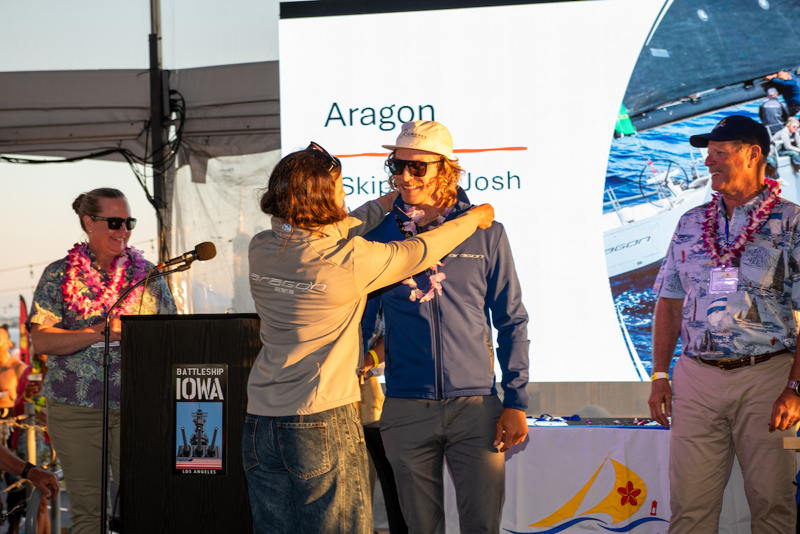
For more information on the 2025 Transpac, including start times, entry list and division breakdowns, the full list of the trophies that will be contested, and the complete listing of all race partners, please visit www.transpacyc.com.
You’ll be able to follow the race at Pasha Yellowbrick race tracker.
Haven Boatworks: Full Service Boatyard in Port Townsend
The Resourceful Sailor Asks, “Will You Shut Your Hawsehole?
When The Resourceful Sailor was preparing the 1985 Pacific Seacraft Flicka 20 Sampaguita for offshore sailing, one consideration was sealing up the hawsehole. (What did you call me?) A hawsehole is a hole in the hull the anchor hawser (rode, line, chain, cable) passes through. It allows a weighed anchor kept on the outside to remain connected (and ready for deployment) to a length of hawser on the inside. On Sampaguita, a more accurate description might be a deck hole. (What are you calling me now?)
Hawsehole is an old British naval shippy term, and Sampaguita is a small, modern recreational vessel. Whatever you call it (or me), they present the same problem. There is a substantial hole in the bow of the boat that can allow copious amounts of seawater in, usually when you most want to keep it out. And aboard Sampaguita, this hole needed to be sealed in some manner.
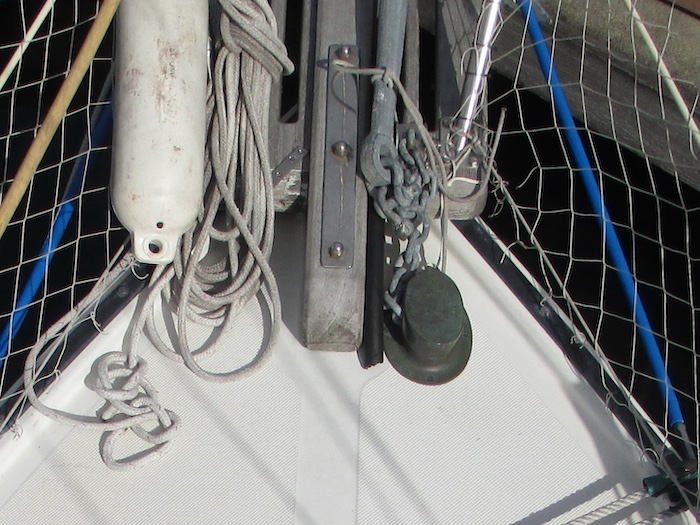
In 10 years of Salish Sea and coastal cruising, Sampaguita’s hawsehole was not a concern. The factory fitting was a bronze oval piece with a flanged lid, held down by the weight of the chain hung from a hook attached to its underside. This applied whether the anchor was deployed or stowed on the bow platform. Once I decided to take an ocean voyage, I felt a need, at least in theory, to seal that hole. (Absolute Rule #1 — keep water out of the boat.) I imagined there were two scenarios. I wanted to make it waterproof with the anchor and chain in place, ready to deploy; and with the two disconnected (and the anchor stowed below).
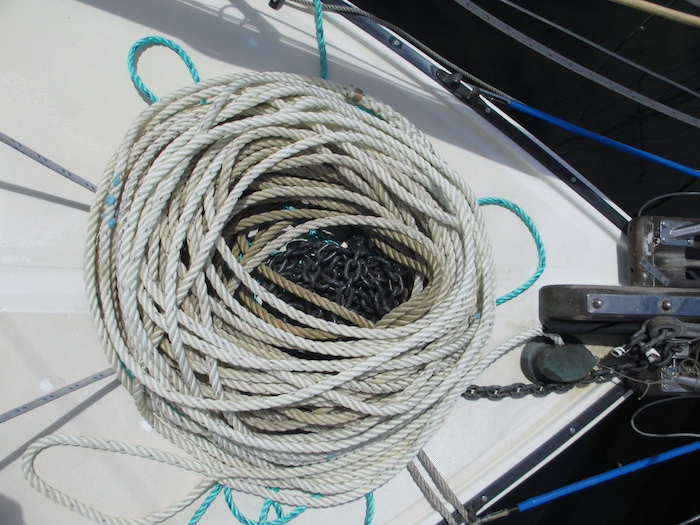
I’d been on the ocean on other people’s boats and couldn’t recall how this issue was addressed. I queried Google to tempt the vast community knowledge base and came across the idea of using a Nerf football. That sounded intriguing enough to give a try. I bought one for $10 from Amazon to see if I could sort it out. The football, whole, was far too big, so I cut it in half across the middle. Then, it fit uncannily well, cut side down. To accommodate the lid’s hook, I poked a hole through the end of the half-Nerf and pushed it through. The compression of the Nerf was sufficient to keep the lid in place, but I still wanted to hook the chain to the lid so that the end would not get lost deep in the chain locker. I thought I had the solution and would have the other half as a spare. Nope. It certainly mitigated the flow of water, but Nerf is not closed-cell foam, and as I inundated the area with hose water and inspected below, I was unhappy with the water that dripped through. I felt there was a better way.
Though a failed experiment, I learned that the problem with a plug was that while it may prevent water from getting below, it wouldn’t keep water on the outside of the fitting altogether. If water collected inside, I would be uncomfortable with that. The exposed wooden deck core had been gel-coated to mitigate water intrusion when the deck hole and fitting were installed, but I still wanted to keep the area dry and well aerated. So I reasoned it would be better to seal the deck hole fitting from the outside. My next solution was an old bicycle inner tube cut lengthways. I snipped off a small piece to put on the underside of the lid, with the hook poking through, to act as a gasket. With the lid on, I wrapped the rest around the bronze fitting on the outside, spanning it and the base. Then, two right-sized hose clamps, one around the base and one around the lid, were tightened down, creating a seal on the top and bottom. The hose test deemed this a success, and I was satisfied to move on. Did I ever use it? Nope.

The inner tube and the Nerf solutions were designed for the anchor and chain disconnected with the anchor stored below, cinched down tightly in storage under the V-berth. While this was a sound theory, it was something different in practice. I had developed this plan for severe weather. In my voyage down the North American west coast to Mexico, over to the Marquesas, and back to Port Townsend, I never had the need to stow the bower. This is good because the plan I developed while at the dock would have been epic to implement (and un-implement) in a developed sea state.
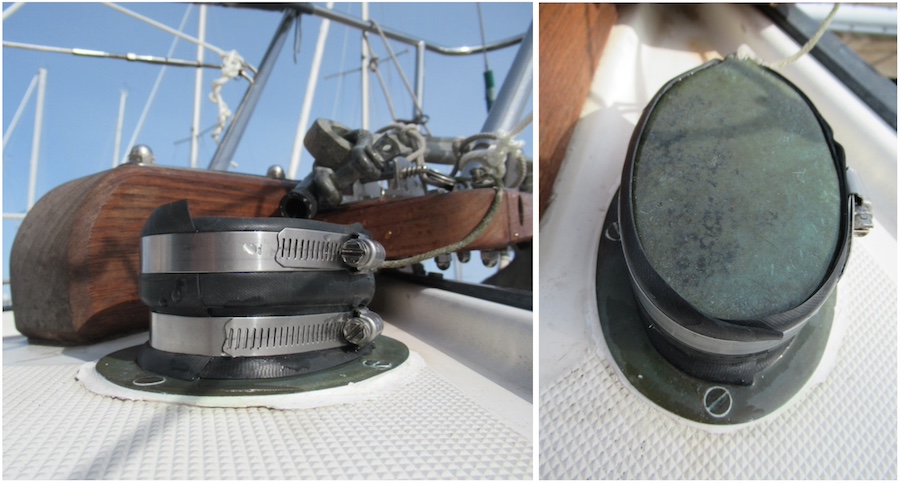
However, I still needed to keep boarding and splashing waves from entering the hawsehole. Sampaguita’s bilge was often bone-dry. In fact, any water at all meant something was amiss. Murky brown meant mud and rust coming from the chain locker and hawsehole. Under all conditions encountered, an old, too-worn-to-wear-except-alone-at-sea, sun-bleached, salt-encrusted cotton T-shirt wrapped around the outside of the bronze fitting and under and around the chain did the trick.
My previous solutions were available, or I would have improvised an alternate solution if conditions arose, which they did not. In preparing, I applied the theory the best I could imagine. In practice, it turned out to be overkill. But you never know, and to ignore the thought felt imprudent. Different boats present different circumstances to solve, so this is an anecdote as you wonder how to solve for your boat. Those two halves of Nerf? They survived as padding on the flukes of the cockpit locker-stowed Bruce anchor.
Remember, keep your solutions safe and prudent, and have a blast.
West Coast Racing Heats Up in July
Racing to Hawaii
At this writing, the 10 solo sailors in the Singlehanded Transpacific Yacht Race are more than two thirds into their voyage to Hanalei Bay, Kauai. They’ll be finishing in the first and second weeks of July. Check their position at www.jibeset.net/tv.php. See our post from the start here.
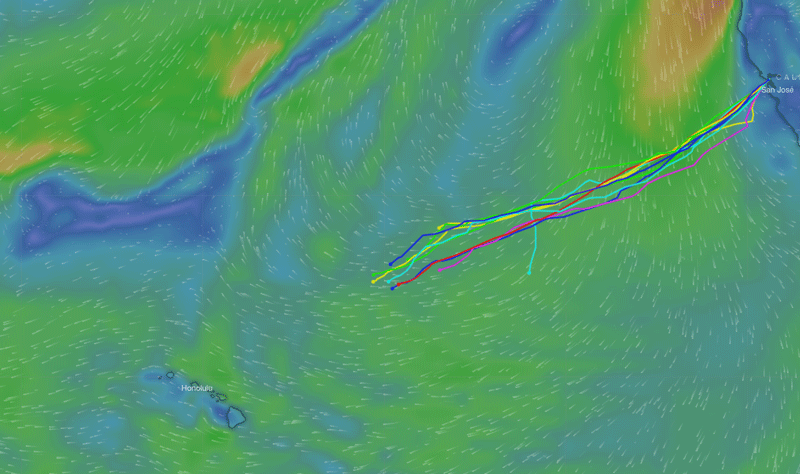
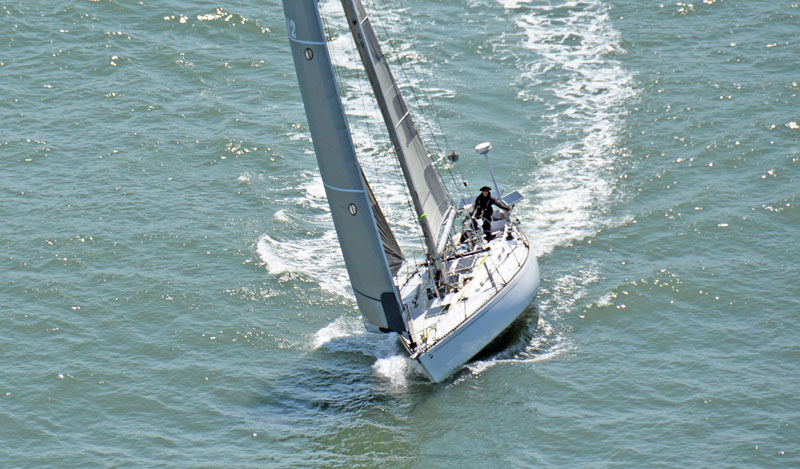
The 53-boat Transpac Race from Los Angeles to Honolulu will start on July 1, 3 and 5, with slower-rated boats starting ahead of faster boats. You’ll be able to follow that race on Yellowbrick via the Pasha Tracker at https://yb.tl/transpac2025. Read much more about the Transpac elsewhere in ‘Lectronic Latitude and in the pages of Latitude 38 magazine.
From the YRA
The Yacht Racing Association offers the following races in July:
- July 12, The Westpoint Regatta Destination Race
- July 19, The Jr Waterhouse Offshore Race
- July 28, The Encinal Regatta Destination Race
Sign up for YRA races on Jibeset.
More in the San Francisco Bay Area
San Francisco Yacht Club will host the 29er Nationals on July 11-13.
Bay View Boat Club invites those of you with vintage fiberglass sailboats 25 or more years old to register in the 40th Plastic Classic on July 19. Following the race, skipper and crew are encouraged to join in on dinner, awards, live music and dancing. Drive or anchor out — BVBC will provide water taxi service till 10 p.m.
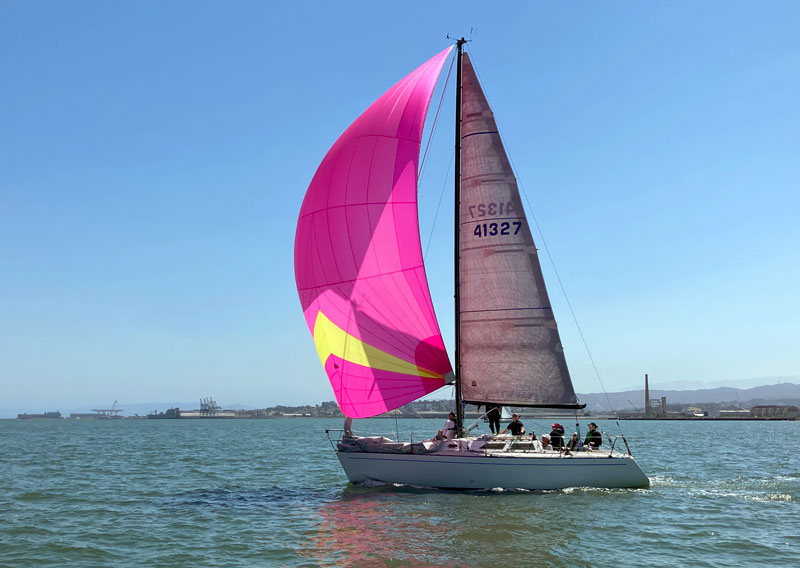
Also on the 19th, St. Francis YC will host the SF Classic/UN Challenge for kiteboards, windsurfers and wingfoils.
“On July 27, the Sunday after the Encinal Regatta, regatta participants and local Estuary boats are invited to experience the pleasures of racing in the Estuary, at the Estuary Extravaganza,” writes Mike DiBella, rear commodore of Encinal YC. “Participants get two races for just $35 (before July 12, then $55 until July 26). The online registration is located on Jibeset at https://jibeset.net/EYC000.php?RG=T008600809.”
Coastside
Monterey Peninsula YC’s Laser Champs will happen on July 19. On the same day, Half Moon Bay YC will run their Take the Tiller women’s regatta. See www.hmbyc.org/sailing/women and www.hmbyc.org/sailing/racing.
Sailing in the Sierra
Lake Tahoe Sail Week will stretch out over July 11-20 and, geographically, from Tahoe City to South Lake Tahoe. Events include buoy races on the 11th; the Trans Tahoe Distance Race on the 12th; Shore to Shore Delivery Races (north to south) on the 13th and 18th; the Southern Crossing Race on the 19th; and a Sail Week Celebration on the 20th. See https://sltwyc.com/2025-sail-week or www.tahoeyc.com.
“Soon, we’ll be out racing the High Sierra Regatta — an event that’s been happening since 1953,” writes regatta chair Mike Trela. “We hope you’ll be back and bring a friend (or two) along.”
- Weekend 1, July 12-13
www.regattanetwork.com/clubmgmt/applet_registration_form.php?regatta_id=29500 - Weekend 2, July 19-20
www.regattanetwork.com/clubmgmt/applet_registration_form.php?regatta_id=29501
Long Beach
Long Beach YC will host the 37th Jessica Uniack Memorial Beach to Bay Race on Thursday, July 10. Dinghies of all shapes and sizes are invited to compete in this classic 5-mile-plus point-to-point race from downtown Long Beach to Alamitos Bay, finishing off the LBYC dock. This makes a great first regatta for beginner sailors and a fun opportunity for racers to hop into a boat they don’t normally sail. The TK Burger Truck will be at the club after racing and the pool party will be in full swing. Each paid competitor will receive a burger ticket. A late fee will kick in on Thursday the 3rd.
LBYC and ABYC will co-host the Long Beach Olympic Classes Regatta on July 12-20. This event is part of the lead-up to the 2028 Olympic Games.
The Grand Finale for the Naples Sabot class will come to LBYC on July 29-August 1 for the 77th Junior Sabot Nationals. A late fee will kick in on July 12.
More in Southern California
San Diego YC will host the Dutch Shoe Marathon for Sabots on July 18.
Cabrillo Beach YC in L.A. will run the ILCA 4 Youth Worlds on July 19-26 and the ILCA 6 Youth Worlds on July 28-August 4.
The 58th Governor’s Cup will sail out of Balboa YC in Corona del Mar on July 29-August 3. The regatta is for match-race skippers under age 23. See www.govcupracing.com.
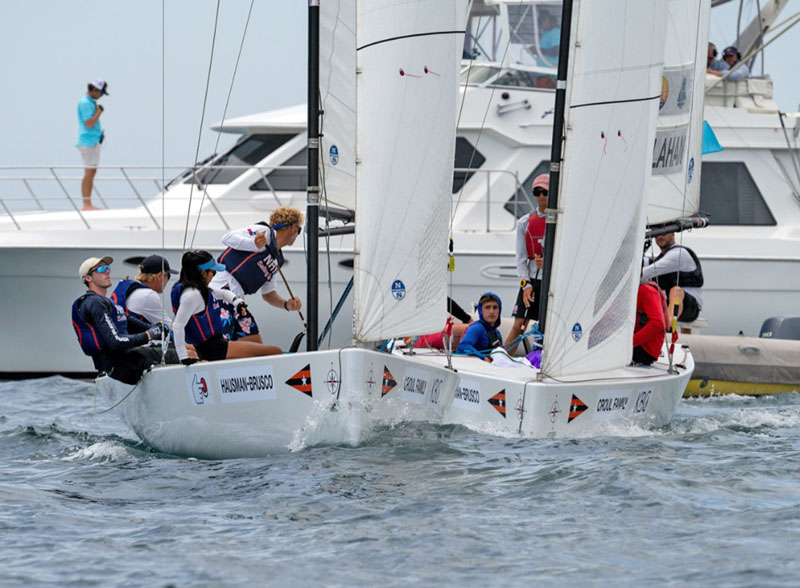
Pacific Northwest
Jericho Sailing Centre in Vancouver, BC, will host the ILCA Masters Pacific Coast Championships on July 4-6.
Pacific Northwest Race Week moves from Anacortes, WA, to Bellingham this year, with the event running July 21-25. See www.raceweekpnw.com.
Moving on down the coast, we come to the Columbia River and CGRA’s Columbia Gorge One Design Regatta (aka C-GOD), sailed out of Cascade Locks, OR, on July 25-27. See https://cgra.org/Regattas_and_Clinics.htm for this and a packed July’s worth of events.
And Much More
Many more regattas dot the month’s calenda, including several on Fourth of July, a Friday this year. Look for them in the Calendar section of Latitude 38’s July issue, coming out tomorrow, Tuesday, July 1. We’ll update our online Calendar tomorrow too.
Eighteen Years Aboard the 85-ft Ketch ‘Nereus’
In Latitude 38’s April issue, we shared a story by Sausalito’s Margaret “Pinkie” Pomeroy about her teenage years cruising aboard her beloved 85-ft steel-hulled, ketch-rigged Nereus. Together with her parents and her two brothers, Pinkie spent six months aboard Nereus, covering 13,490 miles from San Francisco to Singapore, via the Pribilof Islands off the coast of Alaska. Recently Ashlyn Brown from Port Townsend, Washington, read Pinkie’s story and wrote to fill in Nereus’s story across the years since the ship’s last voyage with the Pomeroy family.
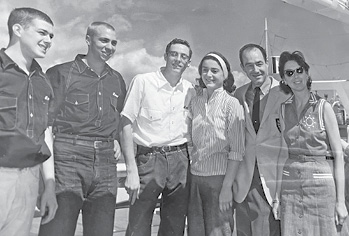
My heart skipped a beat when my husband opened his April Latitude 38 (#574; “Nereus’s World Cruise”), passed it to me, and asked, “Is that the same boat you were on?” Indeed, it was the very same boat I had called work and home as a single mom for 18 years. The Latitude article filled in a large chunk of the boat’s history that I had always wondered about. The bronze plaque on the wall between the galley and pilot house displayed the name Nereus and its build in Tacoma, Washington, in 1962, the Year of the Tiger according to Chinese horoscopes. For that reason, and for its deep, reliable purr, we named the (original) Caterpillar engine El Tigre.
I shall try to provide a timeline, picking up where your article left off, but spoiler alert: The ending is not a happy one. The boat was purchased by an American who renamed it Independence. That would have been in the late 1970s, and I have been able to confirm that they were cruising and chartering in the Mediterranean in the early 1980s. After that cruise, I believe it sat in shallow water behind the owner’s house in Key Biscayne, Florida, until we came along in early 1990.
We found it in sad condition: Abandoned fuel tanks meant rotten steel. A sudden downpour revealed massive leaks in the deck plating. The price suddenly dropped, and my boss at the time closed the deal. The next few months were a flurry of work to re-weld the master cabin floor plating and close leaks in the deck. We built small en-suite heads in each cabin to upgrade for possible charters, installed a new mast and roller furling and new mattresses, repaired the walk-in refrigerator, stocked the boat with long-term provisions, and set sail for the Caribbean. We kept the name in the spirit of all that it implied.
In the 18 years and 75,000 miles I was on board, a lot changed. Almost every year we were replacing hull plating or railings, much of the work done in Trinidad. At one point, my daughter (not the owner’s) participated in the total rebuild of the engine. The aft area of the boat was eventually enclosed as a king-size suite at the request and expense of a major client who was aboard at least twice a year for a while. The saloon was remodeled, and the canvas turtleback on the foredeck was rebuilt in steel, creating a really cute child’s cabin.
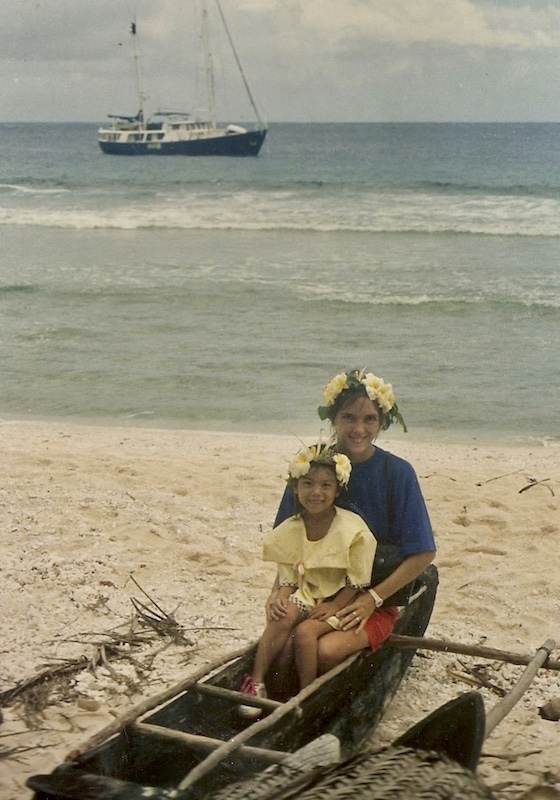
We made eight transatlantic crossings, three Mediterranean round trips to the owner’s home country of Slovenia, two trips to Brazil and voyages up and down the Caribbean. We did two years in the Central Pacific, plus charters back and forth through the Panama Canal and to the San Blas Islands.
Westwind Yacht Management — Washing, Waxing and Varnishing
Westwind Yacht Management: Premiere Yacht & Fleet services for the San Francisco Bay Area.


